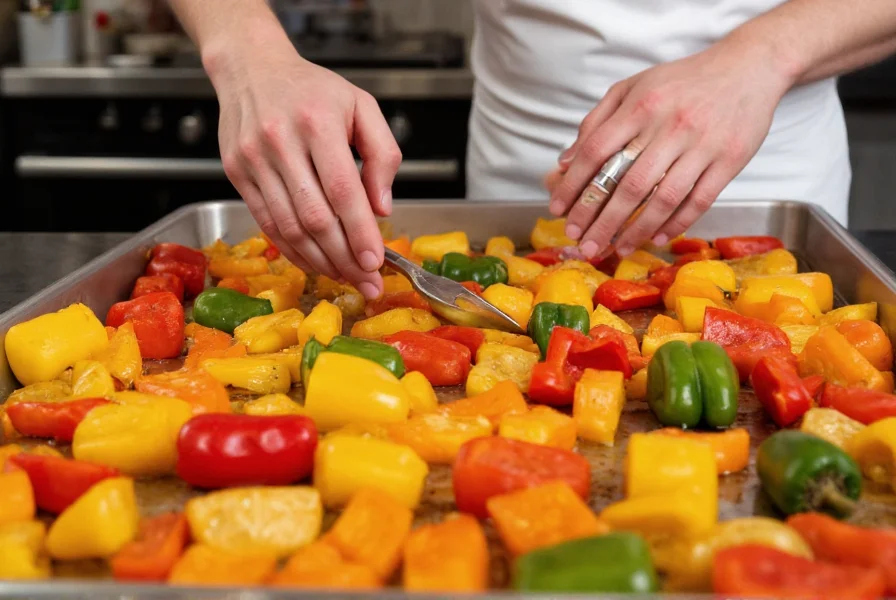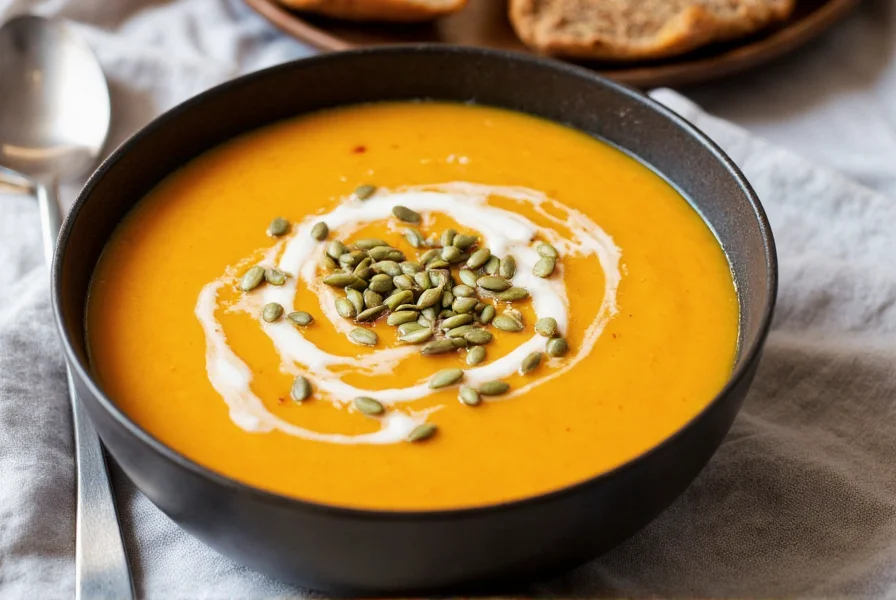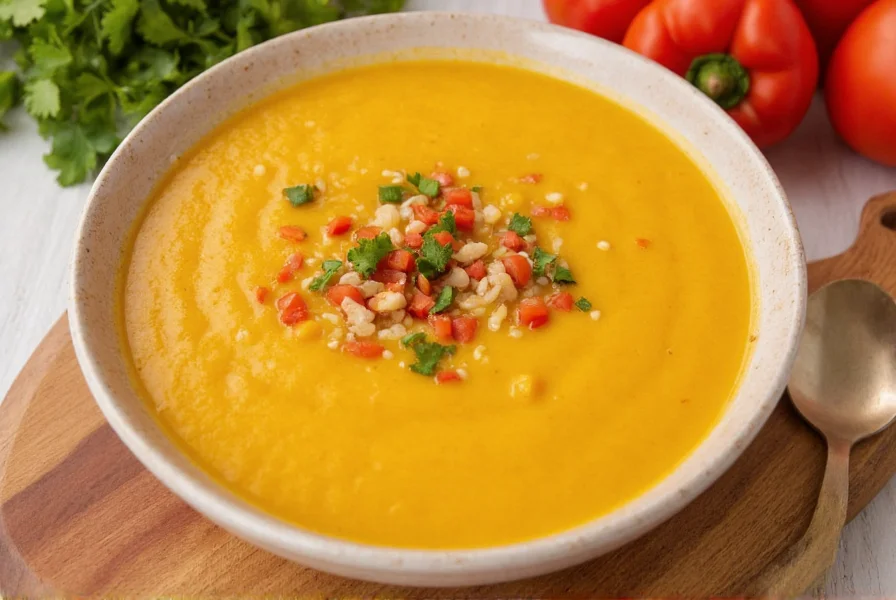Creating exceptional pepper squash soup requires understanding the delicate balance between the squash's natural sweetness and the pepper's subtle heat. This versatile dish works equally well as a comforting winter meal or a light summer starter when served chilled. With proper technique, you can achieve restaurant-quality results in your home kitchen without specialized equipment.
Essential Ingredients for Flavorful Pepper Squash Soup
The foundation of a perfect pepper squash soup starts with quality ingredients. Butternut squash remains the preferred variety due to its smooth texture and sweet flavor profile, though acorn or kabocha squash make excellent alternatives. Choose firm squash with unblemished skin and heavy weight for their size, indicating higher moisture content.
Bell peppers contribute both color and subtle heat—red peppers offer sweetness while green peppers provide more vegetal notes. For an easy pepper squash soup recipe for beginners, select one red and one yellow pepper to balance flavor complexity with approachability. Shallots work better than regular onions for their milder sweetness, while fresh garlic adds necessary depth without overpowering.
| Ingredient | Quantity | Preparation Tip |
|---|---|---|
| Butternut squash | 2 lbs (900g), peeled and cubed | Cut uniform 1-inch cubes for even roasting |
| Bell peppers | 2 medium, seeded and chopped | Roast skins-on for smoky flavor |
| Shallot | 1 large, finely diced | Sweat slowly to develop sweetness |
| Vegetable broth | 4 cups low-sodium | Homemade yields best flavor |
Step-by-Step Preparation Method
Begin by roasting your vegetables to maximize flavor development. Toss squash cubes and whole bell peppers with olive oil, salt, and pepper, then spread on a parchment-lined baking sheet. Roast at 400°F (200°C) for 30-35 minutes until tender and caramelized at the edges. This roasted pepper squash soup preparation technique creates complex flavor compounds that boiling cannot achieve.
While vegetables roast, sauté shallots in olive oil over medium-low heat until translucent (about 8 minutes). Add minced garlic during the last two minutes. The slow cooking process prevents bitterness while developing natural sweetness—critical for a healthy vegetarian pepper squash soup that doesn't require added sugar.
Once roasted, remove pepper skins (they'll peel easily after roasting) and add all vegetables to a pot with sautéed aromatics. Pour in vegetable broth, bring to a simmer, and cook for 15 minutes to allow flavors to meld. For the creamiest texture, use an immersion blender directly in the pot rather than transferring to a countertop blender.

Pro Tips for Perfect Texture and Flavor
Achieving the ideal consistency requires attention to liquid ratios. Start with 3 cups broth, then gradually add more after blending until you reach your preferred thickness. For an exceptionally smooth texture, strain through a fine-mesh sieve—this extra step makes a noticeable difference in creamy pepper squash soup without dairy.
Seasoning requires careful layering: salt the vegetables before roasting, add herbs during simmering, and finish with acid just before serving. A squeeze of fresh lemon juice or apple cider vinegar brightens the flavors and enhances the natural sweetness without adding sugar. For depth, include 1-2 teaspoons of smoked paprika or a sprig of fresh thyme during cooking.
Nutritional Profile and Health Benefits
One serving (1.5 cups) of homemade pepper squash soup typically contains:
- Approximately 180 calories
- 8g dietary fiber (32% of daily value)
- Over 200% of daily vitamin A needs
- Significant vitamin C, potassium, and magnesium
The combination of squash and bell peppers creates a powerful antioxidant profile. Beta-carotene from squash converts to vitamin A in the body, supporting vision and immune function, while bell peppers provide vitamin C that enhances iron absorption from the soup's other ingredients. This makes pepper squash soup particularly valuable as part of a nutrient-dense seasonal eating plan.
Serving Suggestions and Dietary Adaptations
Elevate your soup presentation with thoughtful garnishes that add contrasting texture and flavor. A swirl of coconut milk creates visual appeal while enhancing creaminess for vegan pepper squash soup variations. Toasted pumpkin seeds provide crunch, and fresh herbs like cilantro or chives add color and brightness.
For different dietary needs:
- Vegan option: Use coconut milk instead of cream and ensure broth is certified vegan
- Lower calorie version: Reduce oil to 1 tsp and skip cream garnish
- Protein boost: Add ½ cup white beans before blending

Storage and Reheating Guidelines
Properly stored pepper squash soup maintains quality for up to 5 days in the refrigerator or 3 months in the freezer. Cool completely before transferring to airtight containers, leaving 1-inch headspace for expansion if freezing. When reheating, add a splash of broth or water as the soup thickens when chilled.
The flavors actually improve after 24 hours as ingredients continue to meld—a helpful tip for meal preppers seeking pepper squash soup meal prep solutions. Never reheat frozen soup in a microwave without first thawing, as this creates uneven heating and potential texture issues.
Frequently Asked Questions
Can I make pepper squash soup without roasting the vegetables?
Yes, though roasting significantly enhances flavor. For a quicker version, sauté cubed squash and peppers in batches until softened (about 15 minutes total), then proceed with the recipe. The soup will be lighter in flavor but still delicious—ideal when making easy pepper squash soup recipe for beginners.
What's the best way to peel butternut squash efficiently?
Cut off both ends, then slice the neck from the bulb. Use a vegetable peeler on the neck section. For the bulb, microwave the whole piece for 2-3 minutes to soften the skin, then cut in half and scoop seeds before peeling. This technique works well for pepper squash soup preparation for time-pressed cooks.
How can I fix soup that's too sweet or too spicy?
For excessive sweetness, add acidity with lemon juice or apple cider vinegar (1 tsp at a time). If too spicy, incorporate more roasted squash or a splash of coconut milk. Remember that flavors intensify as the soup sits, so adjust seasoning just before serving for optimal results with your customizable pepper squash soup recipe.
Can I use frozen squash for pepper squash soup?
Yes, frozen squash works well in soups. Thaw completely and pat dry to remove excess moisture before using. You may need to reduce added liquid since frozen vegetables release water during cooking. This approach creates a reliable pepper squash soup recipe for all seasons when fresh squash isn't available.











 浙公网安备
33010002000092号
浙公网安备
33010002000092号 浙B2-20120091-4
浙B2-20120091-4